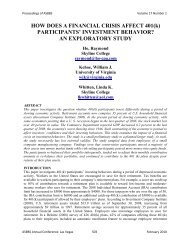Muhammad, Imran; Nadeem, Kureshi & Akmal, Attaullah - Asbbs.org
Muhammad, Imran; Nadeem, Kureshi & Akmal, Attaullah - Asbbs.org
Muhammad, Imran; Nadeem, Kureshi & Akmal, Attaullah - Asbbs.org
- No tags were found...
Create successful ePaper yourself
Turn your PDF publications into a flip-book with our unique Google optimized e-Paper software.
Proceedings of ASBBS Volume 20 Number 1It is also pertinent to mention that Ginning Output ratio (GOT) is decreased in last fourdecades and in contrast during the same period, GOT% of India has seen a growth of around 35%(UNCTAD report ,2005b). Nonetheless, CABI South Asia (2008) reports points out that in lastcouple of years GOT of average in ginning unit is on rise which reflects a bit positive trend. Thecotton losses during entire Ginning chain stand at average 8% (CABI South Asia , 2008)however, it is believed that actual losses could be much higher than estimated as workers involvein ginning lacks formal education and training (CABI South Asia , 2008)PROBLEMS IN GINNING SECTORQuantity of trash is very high, approximately 5%, due use of inferior quality seed as themajor issue faced by ginning units. It is estimated that contamination in cotton goes as high as 19grams per bale (Salam, 2008). Further, existing ginning technology is old as it lacks moisturecontrol system, results in excessive heating of the seed cotton, and is inefficient in trash removal(EDB, 2005). Ginning sector has old machinery and practicing out-dated methods Salam (2008)and has also failed to keep pace with fast changing international standards (Altaf, 2008).Subsequently poor ginning technology results in impaired cotton quality.Saw gins are locally manufactured and entire manufacturing process remained mired withlack of skills and capacity constraints (SMEDA, ud). There are no standards for manufacturingof ginning machinery and no proper ginning practices (EDB, 2005). In addition, quality of seedis also one of the major issues faced by ginning units. This in turn has adversely affected theperformance of higher value added sectors of cotton value chain, more particularly the export ofcotton yarn (Government of Pakistan, 2008,). The reason for this as indicated by SMEDA (2007)include:• Poor handling by middleman, known as Beoparies,• Poor storage places where larger quantity of contaminates is absorbed incotton along with moisture. This in turn increases trash quantitiesmanifold hence causing loss of around US$ 3 billion annually.Power shortage is another dire issue faced by ginning units. This is causing frequentbreak down and disruption in production. Same is resulting in higher production cost. Apartfrom this, no substantial FDI could be lured in the sector partially owing to inconclusivegovernment policies. Further, banks are lending loan to the sector at a very high interest rateswhich is making borrowing difficult. As a result sector is deprived of valuable investment (CABISouth Asia, 2008)SPINNINGSpinning sector not only meets the demand of local industry but at the same time onethird of cotton yarn is exported to other countries (Pakistan economic survey, 2007-08, Noor,2011). At present, there are 10 million spindles and 198 thousand rotors are installed and nearly9 million spindles and 118 rotors are in operation. The capacity utilization has stagnated at 93%in spindles and 59% in rotors during 2009-10 (Noor, 2011). The spinning productivity flow chartis shown in figure - 6 on the following pageASBBS Annual Conference: Las Vegas 795 February 2013
















